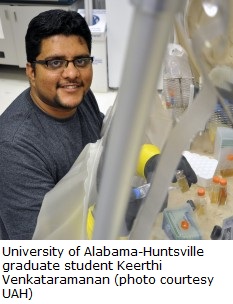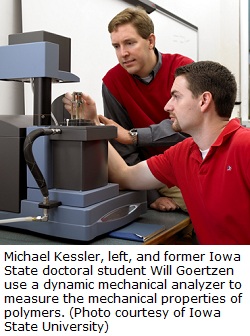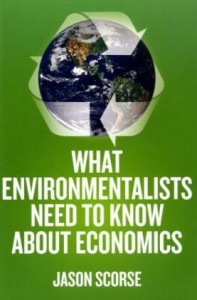 Researchers at the University of Alabama in Huntsville have found a strain of bacteria that could turn glycerol, a by-product of biodiesel production, into another alternative fuel … butanol.
Researchers at the University of Alabama in Huntsville have found a strain of bacteria that could turn glycerol, a by-product of biodiesel production, into another alternative fuel … butanol.
This story from the school’s news website says the research is being done by a graduate student with funding from the National Science Foundation:
Disposing of glycerol has been a problem for the biodiesel industry, according to Keerthi Venkataramanan, a student in UAHuntsville’s biotechnology Ph.D. program. “Many companies have had problems disposing of it. The glycerol you get as a byproduct isn’t pure, so it can’t be used in cosmetics or animal feeds. And purifying it costs three times as much as the glycerol is worth.”
The volume of glycerol produced is also daunting: About 100,000 gallons of glycerol is produced with every million gallons of biodiesel manufactured from animal fats or vegetable oils. (In 2009 more than 500 million gallons of biodiesel were produced in the U.S. while more than 2.75 billion gallons were produced in Europe.)
He is working with the Clostidium pasteurianum bacteria, which “eats” glycerol and produces several potentially useful byproducts.
“This strain is found deep in the soil,” he said. “It was originally studied for its ability to ‘fix’ nitrogen from the air.”
The bacteria uses glycerol as a carbohydrate source. From that they produce three alcohol byproducts — butanol, propanediol and ethanol — plus acetic acid and butyric acid. Butanol is a particularly interesting byproduct.
“Butanol is a big alcohol molecule, twice as big as ethanol,” Venkataramanan said. “You can use it as an industrial solvent and it can be used in cars, replacing gasoline with no modifications. It doesn’t have some of the problems you have with ethanol, such as rapid evaporation. And ethanol is a two-carbon molecule, but butanol is a four-carbon molecule so its energy value is much higher. In fact, there are plans to use it for jet fuel.
The article says that the bacteria also turn glycerin into a chemical used to make plastics. Plus, since it is non-pathogenic, the bacteria are better for the environment.







 “EPA’s decision today is a sound one, but it doesn’t address the issues that still remain regarding a segmented market place and the introduction of a new fuel,” said RFA President Bob Dinneen. “The RFA will continue to work with EPA and other regulatory bodies to expand ethanol use beyond even 15%. Simultaneously, we will continue our dialogue with lawmakers to develop and implement sound, tax-based policies that provide the proper incentives to grow ethanol use across a variety of blending levels.”
“EPA’s decision today is a sound one, but it doesn’t address the issues that still remain regarding a segmented market place and the introduction of a new fuel,” said RFA President Bob Dinneen. “The RFA will continue to work with EPA and other regulatory bodies to expand ethanol use beyond even 15%. Simultaneously, we will continue our dialogue with lawmakers to develop and implement sound, tax-based policies that provide the proper incentives to grow ethanol use across a variety of blending levels.”  “Today’s decision greenlights the use of E15 for nearly two out of every three cars on the road today and furthers proves ethanol is a safe, effective fuel choice for American drivers,” said Renewable Fuels Association President Bob Dinneen. “EPA continues to move in the right direction with respect to increasing ethanol blends, but challenges still remain. The RFA continues to urge EPA to extend the waiver for E15 use to all cars and pickups.”
“Today’s decision greenlights the use of E15 for nearly two out of every three cars on the road today and furthers proves ethanol is a safe, effective fuel choice for American drivers,” said Renewable Fuels Association President Bob Dinneen. “EPA continues to move in the right direction with respect to increasing ethanol blends, but challenges still remain. The RFA continues to urge EPA to extend the waiver for E15 use to all cars and pickups.”  Brian Jennings, Executive Vice President of the American Coalition for Ethanol (ACE), says the move is another important step in making more renewable fuel choices available to consumers. “ACE continues to be confident that the scientific evidence proves E15 is safe and reliable for all cars, and is disappointed that EPA continues to insist of this confusing model-year division, especially when models earlier than 2000 are being excluded without scientific evidence of any issues with using E15 in those vehicles,” said Jennings. “We are pleased with this positive step, but remain concerned about the unnecessary confusion that will unfortunately be caused by EPA’s piecemeal, partial-waiver approach.”
Brian Jennings, Executive Vice President of the American Coalition for Ethanol (ACE), says the move is another important step in making more renewable fuel choices available to consumers. “ACE continues to be confident that the scientific evidence proves E15 is safe and reliable for all cars, and is disappointed that EPA continues to insist of this confusing model-year division, especially when models earlier than 2000 are being excluded without scientific evidence of any issues with using E15 in those vehicles,” said Jennings. “We are pleased with this positive step, but remain concerned about the unnecessary confusion that will unfortunately be caused by EPA’s piecemeal, partial-waiver approach.” The U.S. Environmental Protection Agency (EPA) today waived a limitation on selling gasoline that contains more than 10 percent ethanol for model year (MY) 2001 through 2006 passenger vehicles, including cars, SUVs, and light pickup trucks. The waiver applies to fuel that contains up to 15 percent ethanol – known as E15. EPA Administrator Lisa P. Jackson made the decision after a review of the Department of Energy’s thorough testing and other available data on E15’s effect on emissions from MY 2001 through 2006 cars and light trucks.
The U.S. Environmental Protection Agency (EPA) today waived a limitation on selling gasoline that contains more than 10 percent ethanol for model year (MY) 2001 through 2006 passenger vehicles, including cars, SUVs, and light pickup trucks. The waiver applies to fuel that contains up to 15 percent ethanol – known as E15. EPA Administrator Lisa P. Jackson made the decision after a review of the Department of Energy’s thorough testing and other available data on E15’s effect on emissions from MY 2001 through 2006 cars and light trucks.